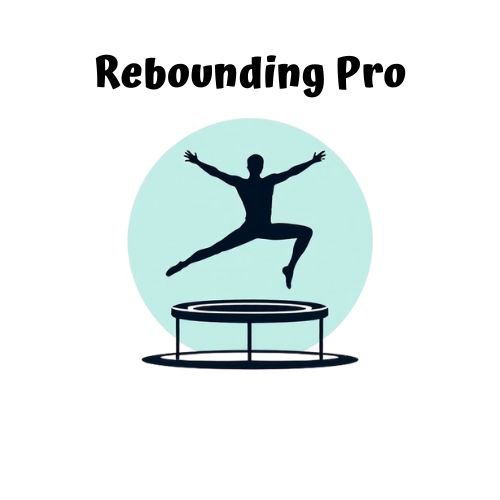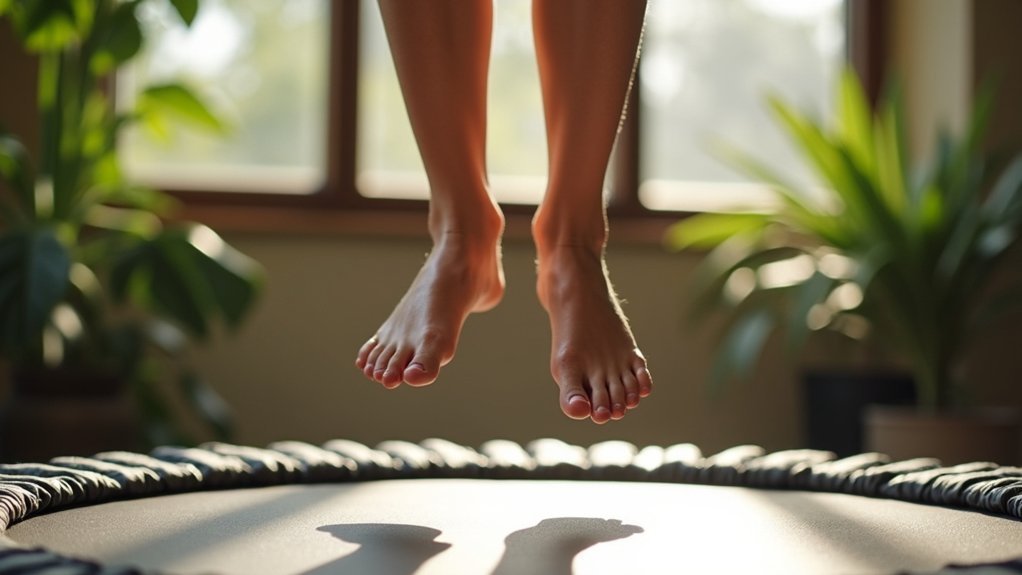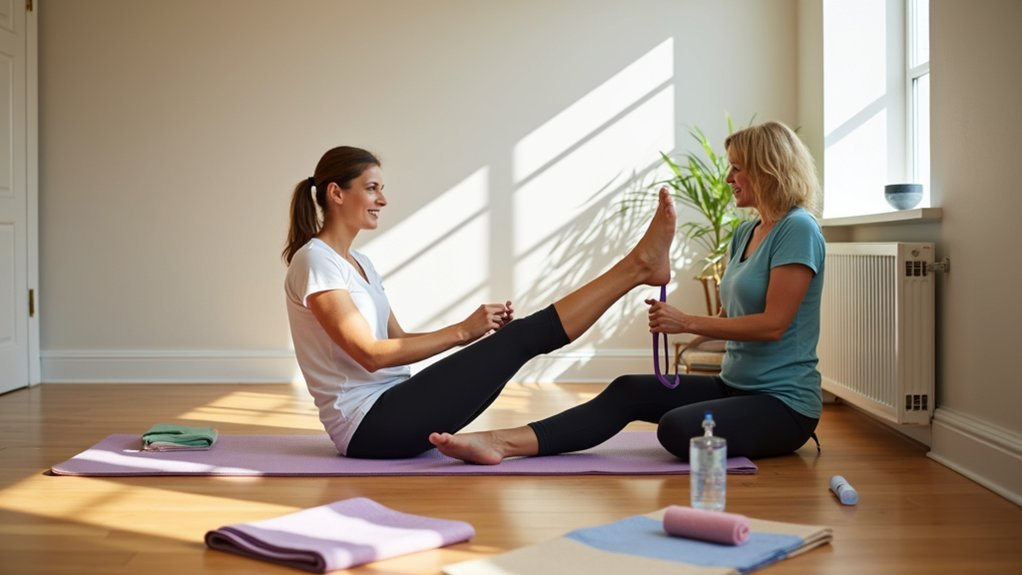Rebounding on a mini-trampoline absorbs over 80% of impact forces while walking transfers full force to your joints. You’ll engage more than 600 muscles when bouncing compared to walking’s limited muscle activation. NASA research confirms trampolines deliver superior cardiovascular benefits, reaching 76.5% of maximum heart rate versus walking’s lower intensity. Your lymphatic system also benefits from the vertical motion that walking can’t provide. Discover how this gentle bouncing can transform your fitness routine.
How Rebounding Reduces Joint Stress by 80

While many exercise options exist for maintaining fitness, rebounding on a trampoline stands out for its remarkable joint protection benefits. The science behind this is compelling—trampolines absorb over 80% of impact forces that would otherwise stress your joints.
When you land on a trampoline mat, its design works with the spring system to act as a powerful shock absorber. This mechanism considerably reduces the jarring impact experienced by your knees, ankles, and spine compared to walking or running on hard surfaces.
The mechanical advantage of rebounding allows you to enjoy cardiovascular benefits similar to running without the associated joint strain. Springfree Trampoline Mats offer even greater protection with their 30 times more shock-absorbent surface compared to traditional spring trampolines. This makes trampolines an ideal exercise option if you’re managing joint conditions, recovering from injuries, or simply want to preserve your joint health for years to come.
Cardiovascular and Lymphatic Benefits: Comparing Trampoline Exercise to Walking
Beyond its joint-protecting qualities, rebounding offers considerable advantages for your cardiovascular and lymphatic systems compared to traditional walking.
When you bounce on a mini-trampoline, your heart works more efficiently—pumping more blood with fewer beats and lowering your resting heart rate. Women who engage in regular intense exercise can reduce their risk of premature death by approximately 30%. You’ll reach about 76.5% of your maximum heart rate during rebounding, noticeably higher than walking’s moderate intensity.
Unlike your circulatory system, your lymphatic system lacks a pump. Rebounding’s vertical motion physically stimulates lymph flow, enhancing toxin removal more effectively than walking’s limited vertical displacement. This improved drainage strengthens immune responses and reduces inflammation.
The lymphatic system relies on body movement—rebounding’s rhythmic bouncing accelerates toxin removal while boosting immune function.
Your oxygen consumption reaches approximately 69% VO2 max on a trampoline versus walking’s typical 50%, indicating more intense aerobic engagement. This higher metabolic demand improves mitochondrial function, heart-lung capacity, and ultimately delivers better cardiovascular outcomes than regular walking.
Mobility Enhancement: Long-Term Effects of Bouncing vs. Strolling

When examining long-term mobility benefits, rebounding consistently outperforms walking through its unique multidirectional movement patterns. This dynamic movement enhances your joint range of motion while simultaneously improving muscle flexibility in multiple planes.
Unlike walking’s linear motion, rebounding requires your muscles and joints to adapt to various directions and forces, reducing stiffness more effectively. The gentle bouncing motion increases blood flow to muscles, accelerating nutrient delivery and waste removal—key factors in maintaining supple, responsive tissues.
You’ll notice improved movement patterns with consistent rebounding, as it challenges your balance and proprioception more intensely than walking. While both activities build mobility-enhancing habits, rebounding’s varied movement demands create better muscle balance and joint resilience over time.
This all-encompassing approach leads to more significant improvements in functional movement and reduced injury risk. Consistency in rebounding exercises is particularly valuable as we age since flexibility diminishes naturally over time, affecting our ability to perform everyday tasks with ease.
Accessibility Factors: Equipment, Cost, and Safety Considerations
Although both exercises offer joint benefits, accessibility factors greatly influence which option suits your lifestyle best.
Walking requires only comfortable shoes and can be done anywhere, making it fundamentally free and universally accessible. In contrast, rebounding demands purchasing a mini trampoline ($50-$500) and adequate space with sufficient ceiling height.
Safety considerations differ too. Walking poses minimal risks but can be jarring to the body on hard surfaces. Rebounding offers exceptional shock absorption that protects your joints, though proper form is vital to prevent injury. The trampoline’s quality directly impacts safety—higher-priced models typically provide better stability and durability.
You’ll find walking more convenient as it requires no setup, while rebounding delivers more intense workouts in shorter timeframes (10-30 minutes) once your equipment is in place. Studies show rebounding can burn calories up to 11 times faster than walking, making it more time-efficient for those with busy schedules.
Muscle Engagement and Bone Density: Which Exercise Provides More Support?

How do rebounding and walking compare when it comes to building strength and supporting your skeleton?
While walking primarily engages your leg muscles, rebounding activates over 600 muscles throughout your body, including core, upper body, and stabilizers. This full-body engagement translates to greater muscle endurance and higher calorie burning.
For bone health, rebounding considerably outperforms walking. NASA studies confirm that rebounding provides stronger biomechanical stimuli for bone density improvement. As a weight-bearing exercise, it helps prevent osteoporosis while distributing G-force more evenly across your body than walking does.
This means less stress on individual joints like knees and ankles. The lower impact nature of rebounding makes it an excellent option for those with joint sensitivity or those recovering from injuries.
You’ll also enjoy improved range of motion with rebounding, making it particularly beneficial for older adults concerned about bone health and mobility.
Frequently Asked Questions
Can Rebounding Help With Weight Loss Compared to Walking?
Yes, rebounding helps you lose weight more efficiently than walking. You’ll burn more calories per minute, engage multiple muscle groups, and boost your metabolism even after you’re done exercising.
How Long Should a Beginner Rebound to See Health Benefits?
As a beginner, you’ll see health benefits by rebounding just 5-10 minutes per session. Start slow and gradually increase your time. You’ll notice improvements when you’re consistent with daily sessions.
Is Rebounding Safe During Pregnancy or With Certain Medical Conditions?
While rebounding isn’t generally recommended during pregnancy due to balance issues, you’ll need your doctor’s approval for any exercise program. With medical conditions, you should get clearance first, as rebounding can be therapeutic when properly supervised.
Can Children Benefit From Rebounding Exercises?
Yes, your children can greatly benefit from rebounding exercises. They’ll develop stronger bones, better balance, improved concentration, and reduced stress. It’s a fun, low-impact activity that supports their physical, cognitive and emotional development.
How Do Weather Conditions Affect the Choice Between Rebounding and Walking?
Weather conditions greatly affect your exercise choices. When it’s raining, snowy, or extremely cold, you’ll likely choose rebounding indoors over walking outside. Rebounding eliminates weather barriers, ensuring you maintain consistent exercise regardless of conditions.
In Summary
You’ll notice significant joint relief when rebounding, experiencing 80% less impact while gaining superior cardiovascular benefits compared to walking. Both exercises improve mobility, though rebounding engages more muscles and builds bone density faster. Consider your budget and space constraints—walking requires no equipment while rebounding needs a mini-trampoline. Whatever you choose, consistency matters most for your long-term joint health.





Leave a Reply